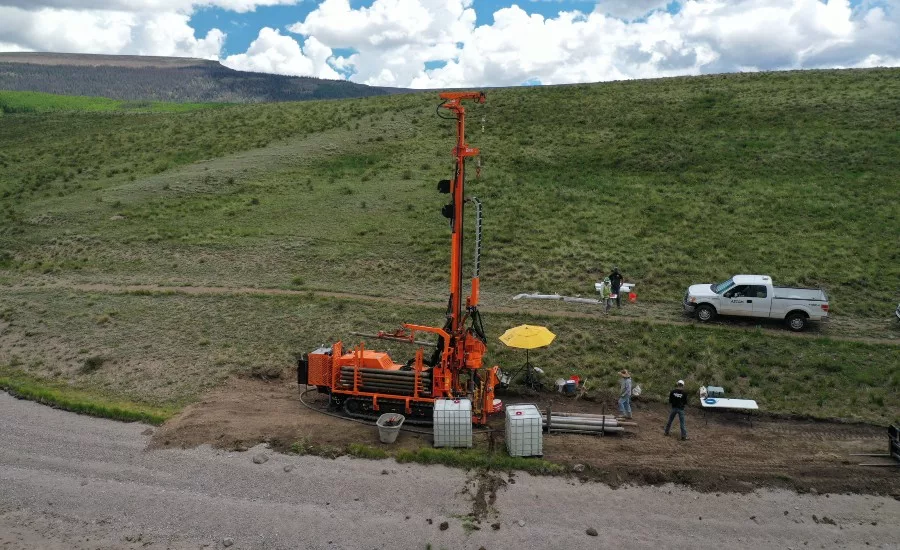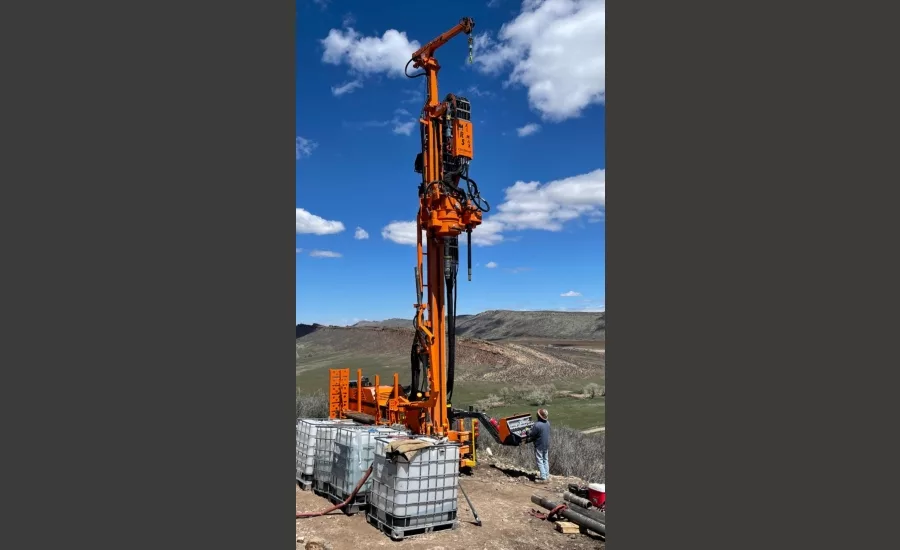Colorado Drilling Contractor Charts Her Path in Environmental, Geotech
‘I Can Do Better,” Former Secretary said of Male-Dominated Industry

Sherri Meiklejohn started Authentic Drilling in 2015 with three rigs, and has bootstrapped the company up to eight rigs in six years.
Source: Authentic Drilling

Authentic Drilling has an in-house training program that pairs junior and senior drillers to facilitate knowledge transfer and training.
Source: Authentic Drilling

Meiklejohn says that, when it comes to field execution, a lot of it rides on the driller and equipment, but operations support is also critical.
Source: Authentic Drilling
What do you believe is the key to creating a 21st-century drilling company? Is it the knowledge within your team? The ability to offer multiple drilling methods. Adopting new technology? Taking on challenging projects?
Scaling and evolving from the 20th century to the 21st century does not involve some secret formula. Start by surrounding yourself with knowledgeable people who utilize their experience to collaborate on challenging projects. Next, apply the right drilling method for safe, swift and efficient execution. Finally, constantly ask yourself if there is a better way.
Authentic Drilling of Kiowa, Colorado, embodies the best of 21st-century drilling. I sat down with Sherri Meiklejohn, owner and president, to learn more about how she guides her company into the future using some of these tactics.
Q. How did you enter the drilling industry?
A. I am from Canada, where I was a legal secretary for 12 years. My husband's work transferred us down to the United States. At that time, I was six weeks pregnant with our first child and worked toward getting my work visa. I did not get my work visa until I was seven months pregnant with my second child. At that point, it was important for me to raise my children, so I did not start seeking work until my youngest was in kindergarten. The best man from our wedding owned a seismic drilling company in Canada that wanted to expand into the United States, and I oversaw his U.S. operations for three years.
Q. After that, you decided to start on your own?
A. No. Next, I accepted an operations job for an environmental and geotechnical drilling company. You know, there is a lot to understand about sampling; it far exceeded what I expected. I took a lot of time to study up and learn all the expectations of environmental and geotechnical. Sadly, that company sold, and the new owner operated it poorly. We lost a lot of business. It was a bad and frustrating situation. So, there I was, sitting at a happy hour with friends, and I said, “I can do better; I am going to start my own drilling company and show these men.”
Q. How did you fund the start-up of a new drilling company?
A. I used some retirement 401(k) directed funds and bootstrapped the rest. It is always easier to do that when you have a spouse with a non-industry-related job to fund your life.
Q. How many years did it take from moving to the States and working for other drilling companies to opening your own drilling company?
A. In 2004, my youngest started kindergarten, and I started my own company in 2015.
Q. Tell me about the first rig you bought.
A. Unfortunately, it's easier to start with used rigs.
Q. That is not unfortunate. We are a heavy capex industry to enter. So, what was your first rig?
A. I like new rigs. Most of our rigs are new. We started with CME. So I was most familiar with them. We started with a buggy, track and truck — all CME. Then we added a 750X-CME buggy. After that, we got an Acker Renegade track rig. Our trend has been to add a rig or two every year.
Q. You started in the beginning with three rigs?
A. Yes, and from 2017 forward, I have added a rig every year — and one year we ordered two. Today, we have eight rigs: three are CME 550X buggies, a CME 750X buggy, a CME 75 truck rig, a CME 55/300 rubber-track rig, one Acker Renegade track rig, and our newest addition, an Eijkelkamp Sonic Duo 275 XL Max track rig.
Q. How did you scale a business with three rigs in 2015 into one with eight rigs in 2021? What did you see or know to feel comfortable saying, “We have the business. We need more equipment”?
A. Two big things helped us move fast. First, I did not take money out of business. My husband’s career helped us live, which made it a lot easier to scale up. The other thing was our team. I know the function of the rigs, and how to push and pull the levers, but I do not have the skillset of the team in the field. I understood how vital everyone is in the company, so I give a 25% net drilling profit to everyone.
Q. I have worked with many companies that institute some sort of bonus structure. Many are footage bonus methods. Explain why you chose a bonus of 25% profit sharing over production?
A. The quality of the sample is important and far exceeds speed or production. We do not bonus on production; I want everyone to share the risk and reward.
Q. How many employees did you start out?
A. We started with seven employees.
Q. When you started, did you have a team in mind?
A. Absolutely.
Q. What did your A-team look like? Mostly drillers?
A. Yes, drillers and drillers that had helpers who made up a team.
Q. Today, how many employees do you have?
A. Twenty-five
Q. Break down your teams for us. How many drillers versus assistants?
A. Most of the team are drillers. I have an in-house training program because there isn’t much formal training out there. We put senior drillers with junior drillers.
Q. Our self-taught tribal culture does not embrace the concept of senior drillers and junior drillers; how did you create that culture?
A. We have that culture because it affects their pocketbook. You are right. Many drillers do not want to share information or their “tricks.” Authentic Drilling has developed a phenomenal ability in-house to brainstorm and troubleshoot projects amongst the whole team. The people who do not fit here are people with egos. I do not keep them. They do not last in our big family. Stupid people and big egos do not last within our company.
Q. What is the average age of your drillers?
A. Thirty. But we do not do battlefield promotions. New people will spend time learning in the field. We specialize in unique projects with limited access that require knowledgeable, skilled people.
Q. What does it take to focus on unique projects?
A. The right people, the right equipment and the best method. It does cost more money for new equipment, and we pay our skilled people appropriately. These aspects can make or break your reputation.
Q. Beyond the equipment and field personnel, what else?
A. When it comes to field execution, a lot of it rides on the driller and equipment. But, also, it is about operations support, from scope change to getting the right materials into the field when conditions change. It is all about keeping the job moving forward. That is very important to us.
Q. What type of limited projects do you take on?
A. We do a lot of work on dams, wind farms, aggregate coring, roads/bridges and other remediation reclamation projects.
Q. Your newest rig investment was into sonic. What made that decision?
A. Our operations manager, Marc Haes, did a lot of research into best methods. We saw a lot of bidding opportunities with sonic. So, we decided to get a rig that can do sonic. However, the Eijkelkamp rig we chose is way cool, it can do more than just sonic. It is a duo-head. So instead of spending a large chunk of time switching methods, you are literally pulling a lever [and] in a short amount of time switching from sonic to coring, to rotary or hammer.
Q. Did you have a driller in mind for the sonic?
A. Yes, we had drillers that ran another, simplistic style of sonic.
Q. Why did you choose that rig?
A. We wanted a rig that had everything mounted on it. Yes, it makes for a heavier load. The critical piece was having the versatility of a duo-mounted head. There is a lot of production value to having the capabilities of sonic on a job, along with traditional methods.
Q. How do you educate your clients about drilling and equipment?
A. There are many have preconceived notions about drilling methods. You can drill anything; it just depends on how long it takes. Obviously, more sampling requires more time. But, when we do educate our clients by getting the equipment out in front of them and showing the success, they go out and sell it for us.
Q. How do you educate your clients on sonic?
A. They love the quality of samples created by sonic, but there is still a lot of education to be had on sonic — like the expectation that everything can be drilled dry. Also speed of sonic can vary depending on downhole conditions — fast in some and slower in others, just like other drilling methods. Finally pricing varies from mines to dams and other projects. It’s all over the board.
Q. What jobs have you done with the sonic rig?
A. Often, jobs are confidential, but the rig is at a dam right now. The last job it was on was and exploration job to better understand a water source.
Q. Talk about sonic on a dam.
A. Traditionally, ODEX had been used, but now sonic is becoming a preferred alternative and the way for the future. It is about minimal impact.
Q. How does your company collaborate with engineers and other industry scientists?
A. We do an annual drilling boot camp here. We invite our clients, engineers and industry experts here. This upcoming year we expect 250 attendees. We do a half-day lecture and half day of field demonstrations for three days. We always focus on log samples but this year we will talk about geophysical logging and hole interpretations. We offer CEUs at our boot camp. This year it is in April 2022.
Q. How do you recruit?
A. More often, our team has someone in mind that they would like to see working for Authentic Drilling.
Q. Are you hiring?
A. Yes. We are always hiring. We offer non-traditional perks for our team such as: a bonus for unsolicited client compliments; a bonus for a pass on DOT Inspections; “Alive in 5,” where if their support truck lasts 5 years the driller gets to keep it; a 5-year retention bonus of $5,000 that must be used for vacation only; and a 10-year retention bonus of $10,000 that must be used for vacation only.
In Ask Brock episode 117, I took on the question: What challenges do women face entering the drilling industry? This discussion puts a spotlight how one powerhouse woman meets and surpasses those challenges. Meiklejohn and her team have a solid, 21st-century drilling company formula. Learn more about them at www.authenticdrilling.com.
Have a Question for Brock?
Drill trainer Brock Yordy takes questions in his ongoing video series, Ask Brock. Find episodes at www.thedriller.com/askbrock. Have a question? Send an email to questions@askbrock.com.
Looking for a reprint of this article?
From high-res PDFs to custom plaques, order your copy today!





